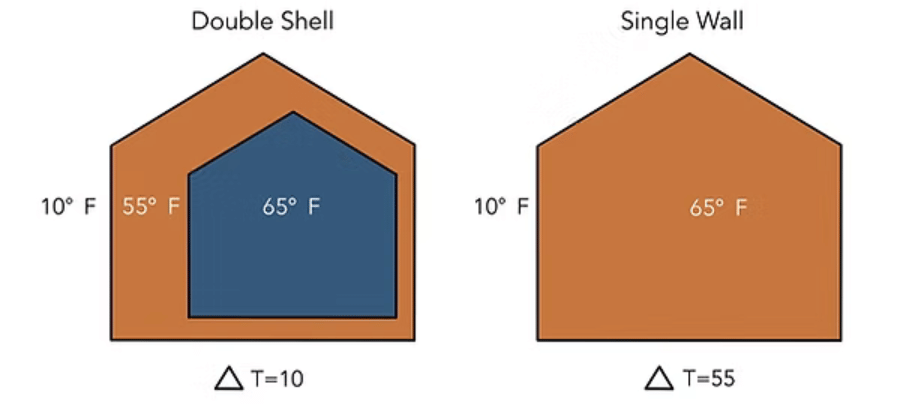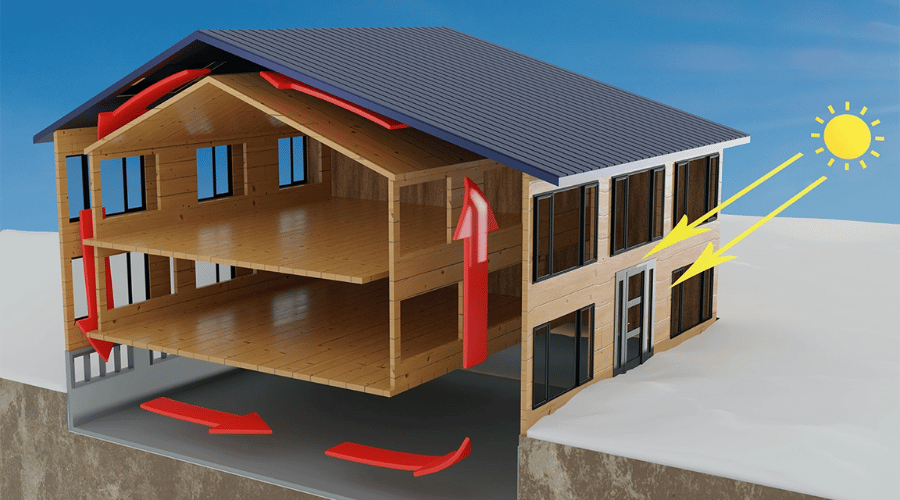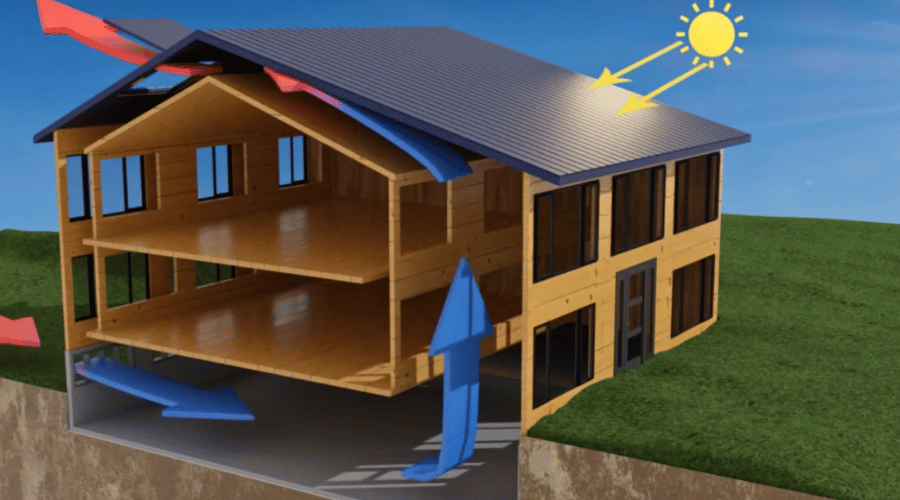The Science Behind Enertia Homes
Advanced Thermal Dynamics for Energy Efficiency
At Enertia Homes, our groundbreaking approach to thermal management sets us apart. This award-winning design combines historically proven techniques with innovative engineering to create the most sustainable, energy-conscious timber homes ever built. We design each home from the ground up to meet the precise needs of your family for your home site. The Enertia design incorporates the strengths of passive solar, geothermal and double wall construction resulting in new level of energy independence that does not rely on costly high-tech equipment, but rather the abundant power of the sun and earth.
The Greenhouse Effect And Biomimicry
Inspired by nature, our designs model biology in a process called biomimicry to create sustainable living environments. We emulate the greenhouse effect by developing a miniature atmosphere within our homes, including internal trade winds and geothermal buffering.
This artificial atmosphere enhances thermal regulation and provides a resilient barrier against external climate fluctuations, ensuring that our homes remain comfortable and sustainable in the face of climate change, regardless of the stability of our power grids.
Enertia Homes are built with double wall construction, creating a breathtaking and livable atmosphere around your home. Our stunning sunrooms and clean fresh basements combine to create this atmospheric buffer. This design forces the warm air of the sun space to rise through the convection loop and fall through the double north wall as the air cools. That same air is then drawn up through vents in the sun space by the evacuating warm air. This creates a natural convection loop powered by “Enertia”, that gently heats the internal walls of the home. This same action brings cool basement temperatures into the loop during the warmer seasons, providing a natural buffer against rising temperatures.

Climate Change Solutions
Bio-Mimicry and the Greenhouse Effect
Inspired by nature, our designs incorporate bio-mimicry to create sustainable living environments. We emulate the greenhouse effect by developing a miniature Earth-like atmosphere within our homes, complete with internal trade winds and geothermal buffering.
This artificial atmosphere enhances thermal regulation and provides a resilient barrier against external climate fluctuations, ensuring that our homes remain comfortable and sustainable in the face of climate change.
Passive Solar
Working in Harmony With The Sun
Enertia Homes feature a large, mostly glass, southern-facing elevation designed to maximize thermal gain. During the winter, the sun is much lower, allowing light and heat to pass through the south-facing glass and be absorbed by the timber walls of our sunspace. During the summer, when the sun’s angle is much higher, large overhangs shade the sunspace from direct sun exposure.
This building methodology called “passive solar” can be traced back to ancient civilizations over 6000 years ago. The advanced engineering of Enertia Homes improves on this time-tested concept by incorporating a convection loop that evenly distributes heat to the interior walls of the home while providing an additional barrier from outside temperatures. Efficiency is further compounded by the geothermal and radiant heat elements of our design.


Geothermal
Working In Harmony With The Earth
While the power of the sun to provide energy is beyond question, the power of the earth to provide heating and cooling has also garnered a growing share of attention. Just as our forests survive extreme temperatures by sending roots below the surface of the earth, our design takes advantage of stable geothermal temperatures. For most places in the United States, this temperature ranges from 55-65 degrees at six feet below grade. These temperatures remain warmer than ambient air during winter months and cooler during summer months, creating an effective heating element and heatsink when you need it most.
For extreme climates, radiant floor heating in the basement not only makes your living space more inviting, it further reduces the challenge of heating your home. Additionally, the steady airflow and sunlight ensures that your basement will be fresh and bright.
Thermal Mass And Enertia
The walls of an Enertia home are built using engineered timbers with the unique ability to gain, hold, and release heat, serving both as structural elements and thermal storage. Thermal storage or, specific heat capacity, of a building material determines the amount of thermal energy that can be stored.
The high resin content of our southern yellow pine acts as a phase change material or PCM, that dramatically increases their specific heat capacity. While heating a PCM through its phase change, additional thermal energy is required to change the PCM’s state from a solid to a liquid (50-60 degrees for southern yellow pine). That additional thermal energy is stored in the PCM and released as it cools. For comparison, concrete has a specific heat capacity of approximately 0.84 kJ/kg·K while high resin southern yellow pine has a specific heat capacity of 2.50 kJ/kg·K. The result is a home with incredible structural integrity and mass that acts as a battery, storing energy to provide comfort in the high-demand hours of the day or during prolonged cloud cover.

Enertia And Biomimicry
The advanced design properties or an Enertia Home can be boiled down to one simple concept, biomimicry. Passive solar overhangs are like a tree growing a dense canopy to shade its roots in the summer. Geothermal energy protects the roots of a tree, keeping its temperature stable. Even the PCM in our timber acts to stabilize a trees core temperature as it grows.
Enertia Homes takes this example one step further by introducing the concept of inertia. Thermal inertia can sustain comfortable temperatures for days, allowing our homes to remain energy-efficient even during extended periods of low sunlight. This capability ensures that Enertia Homes remain comfortable during heat waves and arctic blasts, providing unparalleled resilience and sustainability. In 2007, the Enertia design was awarded the Modern Marvels, “Invention of the Year” award. It is undoubtedly a modern marvel to see the natural, sustainable, and beautiful homes created through this cutting-edge combination of ancient wisdom, natural power, and engineering.

